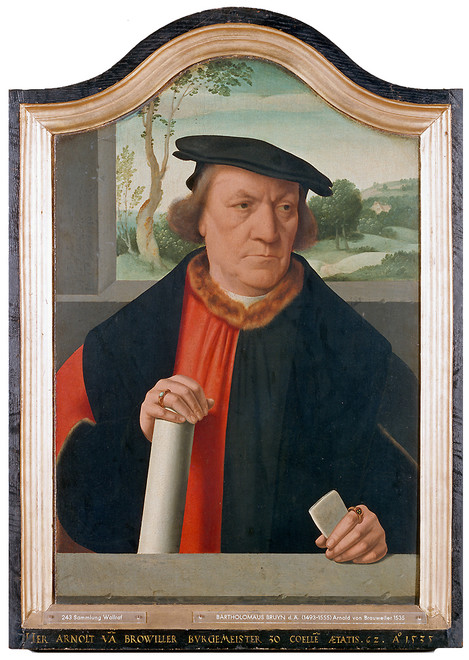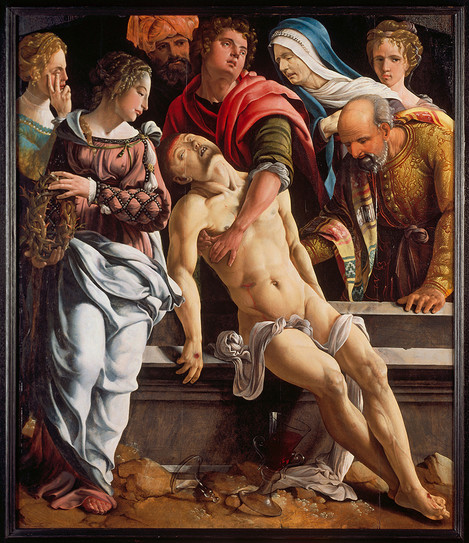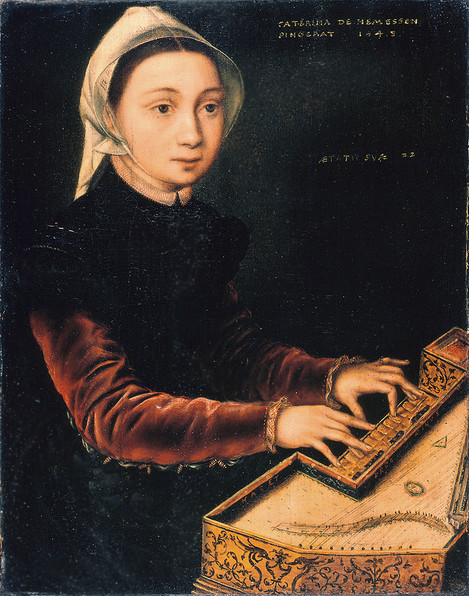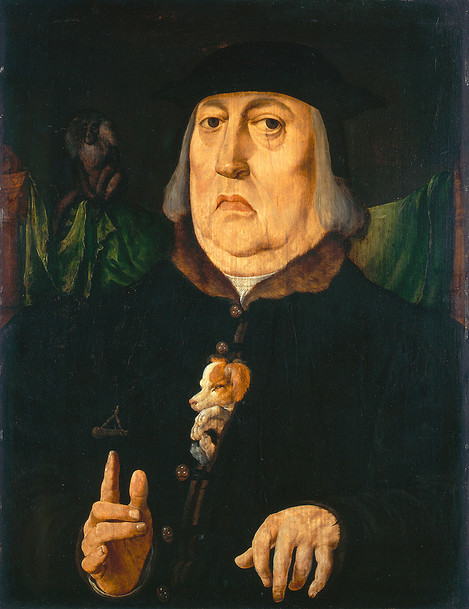THE RENAISSANCE
COMES TO COLOGNE
The last gallery on this floor is dedicated to Bartholomäus Bruyn the elder. From 1533 onward he lived in that magnificent double house where Stefan Lochner (see Galleries 5 and 6) had once lived and painted. Later he handed it on to his son Bartholomäus Bruyn the younger. More than a few of the paintings hanging in this room were painted just a stone’s throw away!
As a specialist in portraiture, Bartholomäus Bruyn was a typical Renaissance artist. This epoch, which followed on from the Middle Ages, was characterised by a new spirit of self-confidence and the revival of antique (Roman and Greek) thought. Bruyn’s paintings reflect these ideals in, for instance, his exact study and rendering of human anatomy. His prodigious Scourged Christ is inconceivable without the inspiration of the works of the Italian Renaissance master Michelangelo. Which brings us back full circle to the first Gallery with the (notably older) Italian paintings. Unlike his Netherlandish contemporary Maerten van Heemskerck, who is represented here by an imposing Entombment of Christ, Bruyn never travelled to Rome. He had only an indirect knowledge of antique and modern Italian art, which was largely gained from copperplates.
But even more than from Italy, Bruyn, who came from the Lower Rhine, drew inspiration from the Netherlands. Which is why his portraits are accompanied here by a number of works from the neighbouring lands. Bruyn was close friends with the Antwerp painter Joos van Cleve. His triptych with the Death of the Virgin was created for a private chapel in Cologne. Compare the donor portraits on the inside of the wings with the individual portraits by Bruyn and you will notice a very similar approach to the human countenance, with striking eyes that stand out from the pale skin of the face.
 Bartholomäus Bruyn, the Elder (Wesel 1493 – 1555 Cologne): Portrait of the Mayor of Cologne Arnold von Brauweiler, 1535. Oak, 57 x 38.5 cm. Collection of Ferdinand Franz Wallraf. WRM 0243. Photo: Rheinisches Bildarchiv Köln
Bartholomäus Bruyn, the Elder (Wesel 1493 – 1555 Cologne): Portrait of the Mayor of Cologne Arnold von Brauweiler, 1535. Oak, 57 x 38.5 cm. Collection of Ferdinand Franz Wallraf. WRM 0243. Photo: Rheinisches Bildarchiv Köln Bartholomäus Bruyn, the Elder (Wesel 1493 – 1555 Cologne): Ecce Homo, c. 1545/48. Oak, 149,5 x 41,5 cm. Collection of Ferdinand Franz Wallraf. WRM 0242. Photo: Rheinisches Bildarchiv Köln
Bartholomäus Bruyn, the Elder (Wesel 1493 – 1555 Cologne): Ecce Homo, c. 1545/48. Oak, 149,5 x 41,5 cm. Collection of Ferdinand Franz Wallraf. WRM 0242. Photo: Rheinisches Bildarchiv Köln Maerten van Heemskerk (Heemskerk 1498 – 1574 Haarlem): The Lamentation of Christ, c. 1530. Oak, 140 x 13157 cm. Acquired in 1928. WRM 0586. Photo: Rheinisches Bildarchiv Köln
Maerten van Heemskerk (Heemskerk 1498 – 1574 Haarlem): The Lamentation of Christ, c. 1530. Oak, 140 x 13157 cm. Acquired in 1928. WRM 0586. Photo: Rheinisches Bildarchiv Köln Catharina van Hemessen (Antwerp 1527/1528 – after 1587): Girl at the Virginal, 1548. Oak, 30.5 x 24 cm. Acquired in 1916 as a bequest from Mrs Emmy Schnitzler, Berlin. WRM 0654. Photo: Rheinisches Bildarchiv Köln
Catharina van Hemessen (Antwerp 1527/1528 – after 1587): Girl at the Virginal, 1548. Oak, 30.5 x 24 cm. Acquired in 1916 as a bequest from Mrs Emmy Schnitzler, Berlin. WRM 0654. Photo: Rheinisches Bildarchiv Köln Jan Cornelisz.Vermeyen (Beverwijk um 1500 – 1559 Brussels): Portrait of a Man (Herman van Gouda?). Oak, 46 x 35 cm. Collection of Ferdinand Franz Wallraf. WRM 0482. Photo: Rheinisches Bildarchiv Köln
Jan Cornelisz.Vermeyen (Beverwijk um 1500 – 1559 Brussels): Portrait of a Man (Herman van Gouda?). Oak, 46 x 35 cm. Collection of Ferdinand Franz Wallraf. WRM 0482. Photo: Rheinisches Bildarchiv Köln Joos van Cleve, the Elder (Joos van der Beke, active in Antwerp 1511 - 1540): Triptych with the Death of Mary, 1515. Oak, 65 x 125,5 cm (cental panel), 67 x 59 cm (wings). Collection of Ferdinand Franz Wallraf. WRM 0430. Photo: Rheinisches Bildarchiv Köln
Joos van Cleve, the Elder (Joos van der Beke, active in Antwerp 1511 - 1540): Triptych with the Death of Mary, 1515. Oak, 65 x 125,5 cm (cental panel), 67 x 59 cm (wings). Collection of Ferdinand Franz Wallraf. WRM 0430. Photo: Rheinisches Bildarchiv Köln


